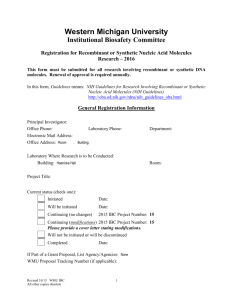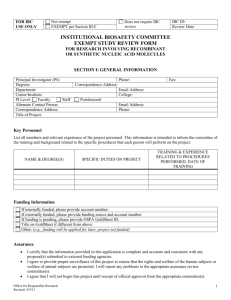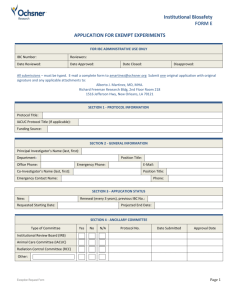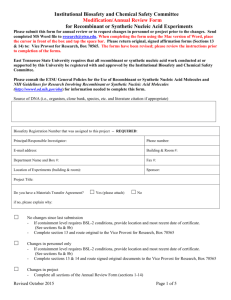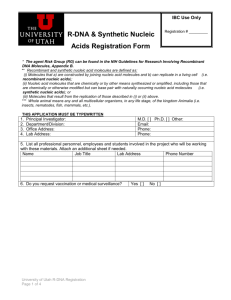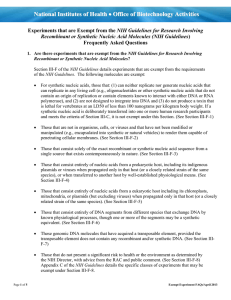Exemption Verification Form - Institutional Biosafety Committee
advertisement
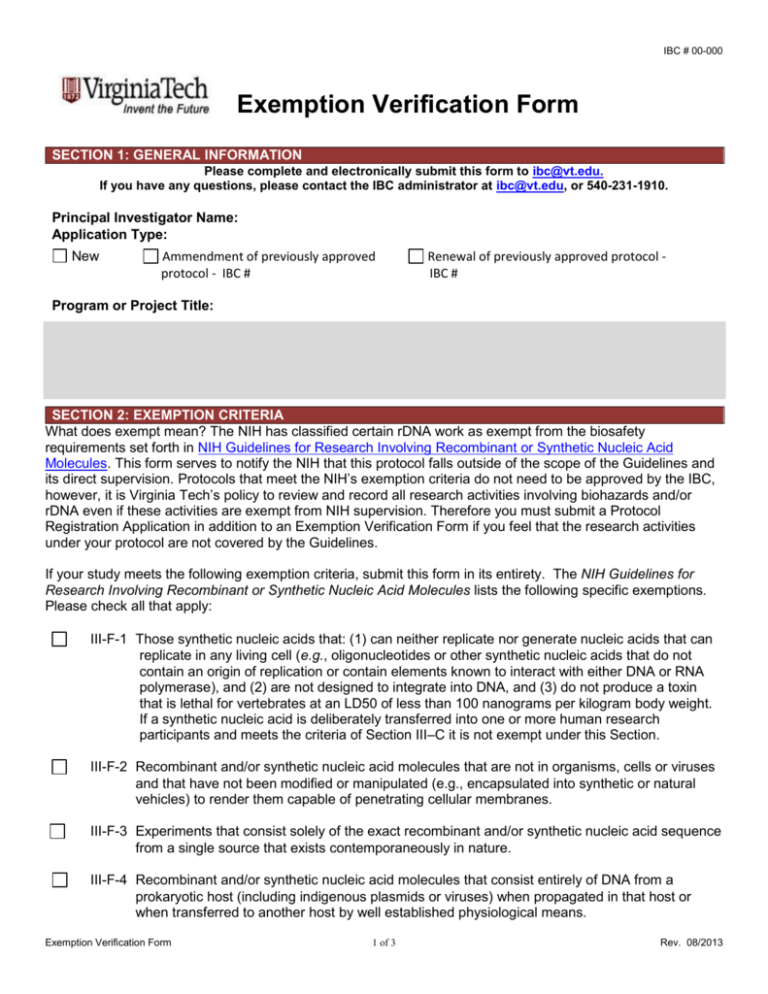
IBC # 00-000 Exemption Verification Form SECTION 1: GENERAL INFORMATION Please complete and electronically submit this form to ibc@vt.edu. If you have any questions, please contact the IBC administrator at ibc@vt.edu, or 540-231-1910. Principal Investigator Name: Application Type: New Ammendment of previously approved protocol - IBC # Renewal of previously approved protocol IBC # Program or Project Title: SECTION 2: EXEMPTION CRITERIA What does exempt mean? The NIH has classified certain rDNA work as exempt from the biosafety requirements set forth in NIH Guidelines for Research Involving Recombinant or Synthetic Nucleic Acid Molecules. This form serves to notify the NIH that this protocol falls outside of the scope of the Guidelines and its direct supervision. Protocols that meet the NIH’s exemption criteria do not need to be approved by the IBC, however, it is Virginia Tech’s policy to review and record all research activities involving biohazards and/or rDNA even if these activities are exempt from NIH supervision. Therefore you must submit a Protocol Registration Application in addition to an Exemption Verification Form if you feel that the research activities under your protocol are not covered by the Guidelines. If your study meets the following exemption criteria, submit this form in its entirety. The NIH Guidelines for Research Involving Recombinant or Synthetic Nucleic Acid Molecules lists the following specific exemptions. Please check all that apply: III-F-1 Those synthetic nucleic acids that: (1) can neither replicate nor generate nucleic acids that can replicate in any living cell (e.g., oligonucleotides or other synthetic nucleic acids that do not contain an origin of replication or contain elements known to interact with either DNA or RNA polymerase), and (2) are not designed to integrate into DNA, and (3) do not produce a toxin that is lethal for vertebrates at an LD50 of less than 100 nanograms per kilogram body weight. If a synthetic nucleic acid is deliberately transferred into one or more human research participants and meets the criteria of Section III–C it is not exempt under this Section. III-F-2 Recombinant and/or synthetic nucleic acid molecules that are not in organisms, cells or viruses and that have not been modified or manipulated (e.g., encapsulated into synthetic or natural vehicles) to render them capable of penetrating cellular membranes. III-F-3 Experiments that consist solely of the exact recombinant and/or synthetic nucleic acid sequence from a single source that exists contemporaneously in nature. III-F-4 Recombinant and/or synthetic nucleic acid molecules that consist entirely of DNA from a prokaryotic host (including indigenous plasmids or viruses) when propagated in that host or when transferred to another host by well established physiological means. Exemption Verification Form 1 of 3 Rev. 08/2013 IBC # 00-000 III-F-5 Recombinant and/or synthetic nucleic acid molecules that consist entirely of nucleic acids from a eukaryotic host (including its chloroplasts, mitochondria, or plasmids BUT excluding viruses) when propagated only in that host. III-F-6 Recombinant molecules that consist entirely of DNA segments from different species that exchange DNA through known physiologic processes, though one or more of the segments may be a synthetic equivalent (See Appendices A-I through A-VI for sub-list of natural exchangers). III-F-7 Experiments involving those genomic DNA molecules that have acquired a transposable element that does not contain any recombinant and/or synthetic DNA. III-F-8 Experiments that do not present a significant risk to health or the environment (See Appendix C for Approved Exemptions). The following classes of experiments are exempt under Section III-F-8, Appendix C C-I Recombinant and/or synthetic nucleic acids in Tissue Culture? Recombinant and/or synthetic nucleic acid molecules containing less than one-half of any eukaryotic viral genome (all viruses from a single family being considered identical – see Appendix C-XI-E Footnotes and References of Appendix C), that are propagated and maintained in cells in tissue culture are exempt from the NIH Guidelines with the exceptions listed in Appendix C-1-A. C-II Escherichia coli K-12 Host-Vector Systems? Experiments which use Escherichia coli K-12 host-vector systems, with the exception of those experiments listed in Appendix C-II-A, are exempt from the NIH Guidelines provided that: (i) the Escherichia coli host does not contain conjugation proficient plasmids or generalized transducing phages; or (ii) lambda or lambdoid or Ff bacteriophages or non-conjugative plasmids shall be used as vectors. However, experiments involving the insertion into Escherichia coli K-12 of DNA from prokaryotes that exchange genetic information with Escherichia coli may be performed with any Escherichia coli K-12 vector (e.g., conjugative plasmid). When a non-conjugative vector is used, the Escherichia coli K-12 host may contain conjugation-proficient plasmids either autonomous or integrated, or generalized transducing phages. For these exempt laboratory experiments, Biosafety Level (BSL) 1 physical containment conditions are recommended. For large-scale fermentation experiments, the appropriate physical containment conditions need be no greater than those for the host organism unmodified by recombinant DNA techniques; the Institutional Biosafety Committee can specify higher containment if deemed necessary. **Common E. coli laboratory strains that are NOT K-12 derivatives (use of these strains is regulated under NIH Guideline III-E): B B-3 BL21 B/R C TOPP C-III Saccharomyces Host-Vector Systems? Experiments involving Saccharomyces cerevisiae and Saccharomyces uvarum host-vector systems, with the exception listed in Appendix C-III-A, are Exempt from the NIH Guidelines. For Exemption Verification Form 2 of 3 Rev. 08/2013 IBC # 00-000 these exempt experiments, BSL1 physical containment is recommended. For large scale fermentation experiments, the appropriate physical containment conditions need be no greater than those for the host organism unmodified by recombinant DNA techniques; the Institutional Biosafety Committee can specify higher containment if deemed necessary. C-IV Kluyveromyces Host-Vector Systems? Experiments involving Kluyveromyces lactis host-vector systems, with the exception of experiments listed in Appendix C-IV-A, are exempt from the NIH Guidelines provided laboratory -adapted strains are used (i.e. strains that have been adapted to growth under optimal or defined laboratory conditions). For these exempt experiments, BSL1 physical containment is recommended. For large-scale fermentation experiments, the appropriate physical containment conditions need be no greater than those for the host organism unmodified by recombinant DNA techniques; the Institutional Biosafety Committee may specify higher containment if deemed necessary. C-V Bacillus subtilis or Bacillus licheniformis Host-Vector Systems? Any asporogenic Bacillus subtilis or asporogenic Bacillus licheniformis strain which does not revert to a spore-former with a frequency greater than 107 may be used for cloning DNA with the exception of those experiments listed in Appendix C-V-A, Exceptions. For these exempt laboratory experiments, BSL1 physical containment conditions are recommended. For large scale fermentation experiments, the appropriate physical containment conditions need be no greater than those for the host organism unmodified by recombinant DNA techniques; the Institutional Biosafety Committee can specify higher containment if deemed necessary. C-VI Recombinant and/or synthetic nucleic acid molecules derived entirely from extrachromosomal elements of the organisms listed in Appendix C-VI (including shuttle vectors in Appendix C), propagated and maintained in organisms in Appendix C-VI are exempt from the NIH Guidelines. C-VII The Purchase or Transfer of Transgenic Rodents? The purchase or transfer of transgenic rodents for experiments that require ABSL1 containment are exempt from the NIH Guidelines. C-VIII Generation of BSL 1 Trangenic Rodents via Breeding? Breeding of two different transgenic rodents or breeding of a transgenic rodent and a nontransgenic rodent with the intent of creating a new strain of transgenic rodent that can be housed at BSL1 if: o Both parental rodents can be housed under BSL-1 containment. o Neither parental transgenic rodent contains the following genetic modifications (i) incorporation of more than one-half of the genome of an exogenous eukaryotic virus from a single family of viruses; (ii) incorporation of a transgene that is under the control of a gammaretroviral Long Terminal Repeat (LTR). o The transgenic rodent that results from this breeding is not expected to contain more than one-half of an exogenous viral genome from a single family of viruses. Exemption Verification Form 3 of 3 Rev. 08/2013
